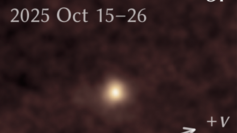The total lunar eclipse on May 15 was witnessed by NASA's Lucy spacecraft, which is currently on its way to asteroids orbiting the sun at the same distance as Jupiter.
NASA has released a brief black-and-white timelapse video that shows the rotating Earth on the left and the moon passing through the planet's shadow on the right. The series comprises photos captured over a three-hour period beginning at 9:40 p.m. EDT on May 15 and finishing at 12:30 a.m. EDT on May 16. The observations came to an end just as the moon was about to leave the planet's shadow.
NASA claimed in a statement that the moon's brightness in the photographs had to be artificially increased by a factor of six to make the natural satellite visible.
Lucy was 64 million miles (100 million kilometers) from Earth at the time of the new moon, covering nearly 70% of the distance between Earth and the sun. According to NASA, Earth and its companion appeared only 0.2 degrees apart to Lucy at this distance, the same separation as a car's taillights when viewed from a quarter-mile (400 meters).
The time-lapse film was captured by the spacecraft's high-resolution panchromatic camera, L'LORRI.
Lucy, which was launched in October 2021, is on a graceful trajectory that will allow it to fly through many Trojan asteroids, which follow and precede the gas giant Jupiter in its orbit around the sun.
Lucy's $981 million mission is the first to target Jupiter's so-called Trojan entourage: thousands, if not millions, of asteroids that share Jupiter's vast orbit around the sun. Some Trojan asteroids orbit Jupiter before it, while others trail it.
Despite their orbits, the Trojans are far from the planet and generally spread out. So Lucy has almost no chance of being swarmed by one as it swoops past its targets.
Lucy will hunt down five asteroids in the front pack of Trojans in the late 2020s, powered by two massive circular solar wings. In 2030, the spacecraft will return to Earth for another gravity assist. Lucy will then return to the trailing Trojan cluster in 2033, when it will fly past the final two targets for an unprecedented total of eight asteroids visited in a single journey.
Lucy is currently en route to Earth for a gravity-assist maneuver that will propel it beyond Mars' orbit. In 2025, Lucy will collide with its first asteroid, Donaldjohanson, named after the discoverer of the renowned ancient human skeleton Lucy.




